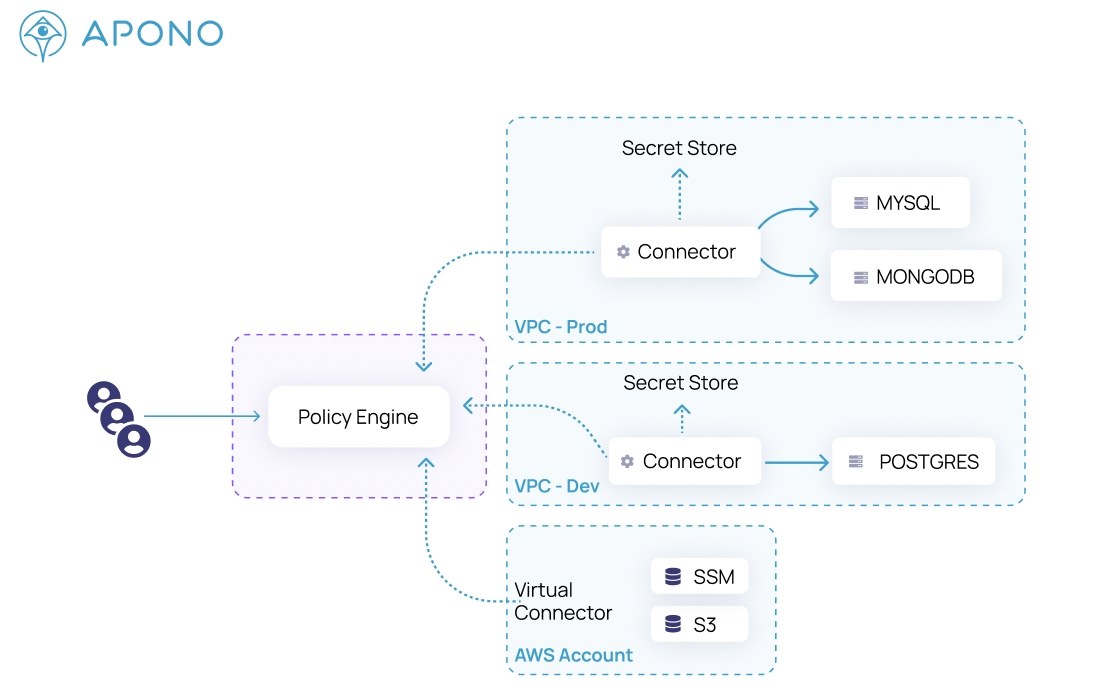How Apono Works
Apono syncs with your apps' data, grants and revokes access
How Apono Works
Your Questions
How does Apono securely integrate with your environment?
How are Access Flows defined and managed?
How do developers request and approve access?
How do admins manage access logs and audit reports?
Great questions, let's get to it:
Integrate with Apono in 3 easy steps
Three easy steps are what it takes to create Just-In-Time and Just Enough permissions for everyone with access to your cloud assets and resources.
1. Install a Connector
Connectors are the components that mediate between Apono and your resources to sync data from cloud applications and grant and revoke access permissions.
The Connector does not read, cache or store any secrets, nor does Apono need an account with admin privileges to function. The Connector contacts your secret store or key vault when it needs to sync data or provision access.
Here's how Connectors work:

2. Integrate With Cloud Apps
After you've installed the Connector, integrate Apono with your cloud applications to sync data on users, groups, resources and permissions.
Apono currently has integrations for 35+ resource types in AWS, GCP, Azure and Kubernetes platforms, as well as development and CI/CD tools, databases, incident response tools, IdP, ChatOps products, and more. Check the Integrations Catalog for details and to see the latest.
3. Create Access Flows
Create an Access Flows by answering five questions:
Who should get access?
What can they gain access to?
What Actions will they be able to perform?
How Long should they have the access?
Who must Approve the request?

Fill in the blanks using information from drop-down lists, click Create, and you're done.
Apono is Self-Serve
Apono is completely self-serve! Curious? Try it for yourself (no demo needed)!
Connect and disconnect the Apono connector and cloud resources at will

Using Terraform? Edit your Terraform .tf file to add Apono access management to your resources
Add Apono to Your IaC Configurations
Open-source Terraform or AWS ecosystem, Apono is a recognized provider for both.
Prepare Terraform configuration scripts by referring to the Terraform Installation Guide. You will also need the Integrations Metadata to learn what to included in each Apono resource.
Apono's Terraform provider is great for creating and managing integrations, as well as Access Flows!
Just Add Slack or Teams
Apono is built with DevX in mind. With Apono, developers can:
Gain automatic access without waiting for approval if the Access Flow allows it
Get access details directly in Slack, Teams or CLI and use them with ease
No more complex forms, old service systems, proxies and clients to install, or hackling your IT department when you need to get work done.
That's why thousands of engineers use Apono for access requests every month!

Audit and Report on Access
Apono automates access logs and audit reports:
Every access request and action are fully logged
Query logs to get exactly what you need, even with our Public API!
Periodic reports and compliance needs? No problem! Create, save, download and schedule reports at will. We'll send it directly to your inbox.
Last updated
Was this helpful?
